Solved Examples
1. The pressure of air in the bulb of a constant volume gas thermometer is 73 cm of mercury at 0°C, 100.3 cm of mercury at
100°C and 77.8 cm of mercury at room temperature. Find the room temperature in centigrades.
![]()
Questions for Short answer
1. If two bodies are in thermal equilibrium in one frame will they be in thermal equilibrium in all frames?
2. Does the temperature of a body depend on the frame from which it is observed?
3. It is heard sometimes that mercury is used in defining the temperature scale because it expands uniformly with the
temperature. If the temperature scale is not yet defined, is it logical to say that a substance expands uniformly with the temperature?
4. In defining the ideal gas temperature scale, it is assumed that the pressure of the gas at constant volume is proportional to the temperature T.
How can we verify whether this is true or not? Are we using the kinetic theory of gases? Are we using the experimental result that the
pressure is proportional to temperature?
5. Can the bulb of a thermometer be made of an adiabatic wall?
6. Why do marine animals live deep inside a lake when the surface of the lake freezes?
7. The length of a brass rod is found to be smaller on a hot summer day than on a cold winter day as measured by the same aluminium scale.
Do we conclude that brass shrinks on heating?
8. If mercury and glass has equal coefficient of volume expansion, could we make a mercury thermometer in a glass tube?
9. The density of water at 4°C is supposed to be 1000 kg/m3 . Is it same at the sea level and a high altitude?
10. A tightly closed metal lid of a glass bottle can be opened more easily if it is put in hot water for some time. Explain.
11. If an automobile engine is overheated, it is cooled by putting water on it. It is advised that the water should be put slowly
with engine running. Explain the reason.
12. Is it possible for two bodies to be in thermal equilibrium if they are not in contact?
13. A spherical shell is heated. The volume changes according to the equation ![]() . Does the volume refer to the
. Does the volume refer to the
volume enclosed by the shell or the volume of the material making up the shell?
Objective - I
1. A system X is neither in thermal equilibrium with Y nor with Z. The system Y and Z
(A) must be in thermal equilibrium (B) cannot be in thermal equilibrium
(C) may be in thermal equilibrium (D) None of these
2. Which of the curves in figure represents the relation between Celsius and Fahrenheit temperature?
3. Which of the following pairs may give equal numerical values of the temperature of a body?
(A) Fahrenheit and kelvin (B) Celsius and kelvin (C) kelvin and platinum
4. For a constant volume gas thermometer, one should fill the gas at
(A) low temperature and low pressure (B) low temperature and high pressure
(C) high temperature and low pressure (D) high temperature and high pressure.
5. Consider the following statements.
(A) The coefficient of liner expansion has dimension K-1
(B) The coefficient of volume expansion has dimension K-1
(A) A and B are both correct. (B) A is correct but B is wrong.
(C) B is correct but A is wrong. (D) A and B are both wrong.
6. A metal sheet with a circular hole is heated. The hole
(A) gets large (B) gets smaller (C) remains of the size (D) gets deformed
7. Two identical rectangular strips, one of copper and the other of steel, are rivetted together of form a
bimetallic strip (acopper>asteel). On heating, this strip will
(A) remain straight (B) bend with copper on convex side
(C) bend with steel on convex side (D) get twisted

10. The temperature of water at the surface of a deep lake is 2oC. The temperature expected at the bottom is
(A) 0oC (B) 2oC (C*) 4oC (D) 6oC
11. An aluminium sphere is dipped into water at 100 C. If the temperature is increased, the force of buoyancy
(A) will increase (B) will decrease (C) will remain constant
(D) may increase of decrease depending on the radius of the sphere.
Objective - II
1. A spinning wheel is brought in contact with an identical wheel spinning at identical speed. The wheels slow down under the
action of friction. Which of the following energies of the first wheel decrease?
(A) kinetic (B) total (C*) mechanical (D) internal
2. A spinning wheel A is brought in contact with another wheel B initially at rest. Because of the friction at contact,
the second wheel also starts spinning. Which of the following energies of the wheel B increase
(A) kinetic (B) total (C) mechanical (D) internal
3. A body A is placed on a railway platform and an identical body B in moving train. Which of the following energies
of B are greater than those of A as seen from the ground ?
(A) kinetic (B) total (C) mechanical (D) internal
4. In which of the following pairs of temperature scales, the size of a degree is identical ?
(A) mercury scale and ideal gas scale (B) Celsius scale and mercury scale
(C) Celsius scale and ideal gas scale (D) ideal gas scale and absolute scale
5. A solid object is placed in water contained in an adiabatic container for some time. The temperature of water falls during
the period and there is no appreciable change in the shape of the object. The temperature of the solid object.
(A) must have increased (B) must have decreased
(C) may have increased (D) may have remained constant.
6. As the temperature is increased, the time period of a pendulum
(A) increases proportionately with temperature (B) increase
(C) decrease (D) remains constant
Worked Out Examples
1. The pressure of the gas in a constant volume gas thermometer at steam point (373.15 K) is
1.50 × 104 Pa. What will be the pressure at the triple point of water?
Sol. The temperature in kelvin is defined as
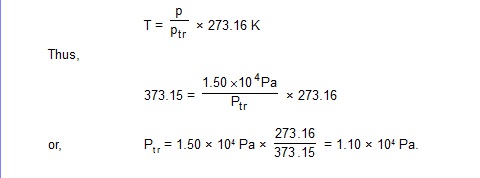
2. The pressure of air in the bulb of a constant volume gas thermometer at 0°C and 100°C are 73.00 cm and 100 cm
of mercury respectively. Calculate the pressure at the room temperature 20°C.
Sol. The room temperature on the scale measured by the thermometer is

3. The pressure of the gas in a constant volume gas thermometer is 80 cm of mercury in melting ice at 1 atm. When the bulb is
placed in a liquid, the pressure becomes 160 cm of mercury. Find the temperature of the liquid.
Sol. For an ideal gas at constant volume,

4. In a constant volume gas thermometer, the pressure of the working gas in measured by the difference in the levels of mercury in
the two arms of a U-tube connected to the gas at the end. When the bulb is placed at the room temperature 27.0°C, the mercury
column in the arm open to atmosphere stands 5.00 cm above the level of mercury in the other arm. When the bulb is placed in a
hot liquid, the difference of mercury levels becomes 45.0 cm. Calculate the temperature of the liquid. (Atmospheric pressure = 75.0 cm of mercury)
Sol. The pressure of the gas = atmospheric pressure + the pressure due to the difference in mercury levels.
At 27°C, the pressure is 75 cm + 5 cm = 80 cm of mercury. At the liquid temperature, the pressure is 75 cm

5. The resistance of a platinum resistance thermometer at the ice point, the steam point and the boiling point of sulphur are 2.50, 3.50 and
6.50 ohm respectively. Find the boiling point of the sulphur on the platinum scale. The ice point and the steam point measure 0° and 100° respectively.
Sol. The temperature on the platinum scale is defined as

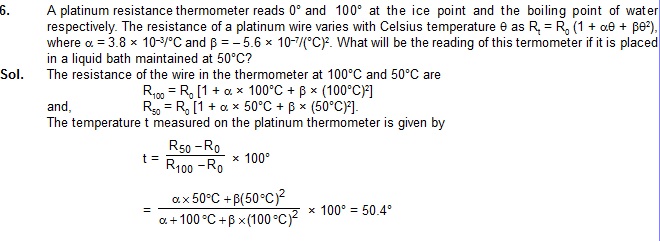
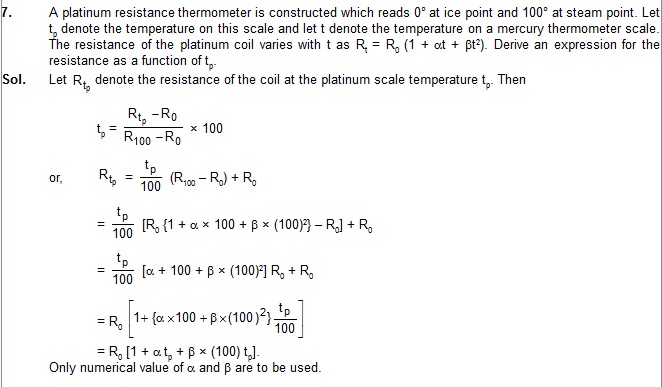
Only numerical value of a and b are to be used.
8. An iron rod of length 50 cm is joined at an end to an aluminium rod of length 100 cm. All measurements refer to 20°C. Find the length
of the composite system at 100°C and its average coefficient of linear expansion. The coefficient of linear expansion of iron and aluminium
are 12 × 10–8 /°C and 24 × 10–6 /°C respectively.
Sol. The length of the iron rod at 100°C is
l1 = (50 cm) [1 + (12 × 10–11/°C)(100°C - 20°C)] = 50.048 cm.
The length of aluminium rod at 100°C is
l2 = (100 cm) [1 + (24 × 10–6/°C) (100°C – 20°C)]
= 100.192 cm
The length of the composite system at 100°C is
50.048 cm + 100.192 cm = 150.24 cm.
The length of the composite system at 20°C is 50 cm.
So, The average coefficient of linear expansion of the composite rod is

9. An iron ring measuring 15.00 cm in diameter is to be shrunk on a pulley which is 15.05 cm in diameter. All measurements refer to the
room temperature 20°C. To what minimum temperature should the ring be heated to make the job possible? Calculate the strain developed
in the ring when it comes to the room temperature. Coefficient of linear expansion of iron = 12 × 10–6/°C.
Sol. The ring should be heated to increase its diameter from 15.00 cm to 15.05 cm.
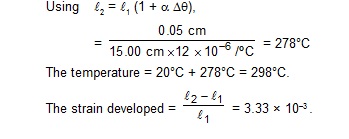
10. A pendulum clock consists of an iron rod connected to a small, heavy bob. If it is designed to keep correct time at 20°C, how fast or
slow will it go in 24 hours at 40°C? Coefficient of linear expansion of iron = 1.2 × 10–6 /°C.
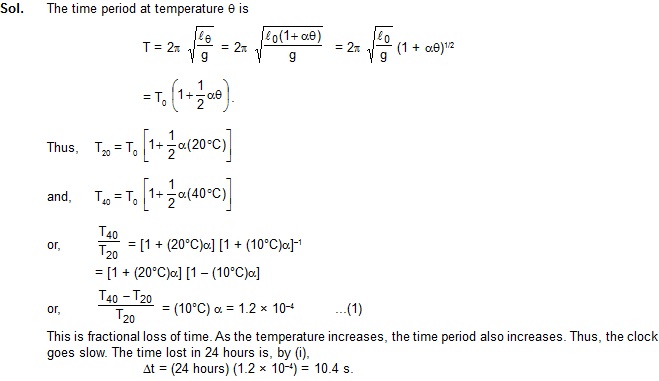
11. A pendulum clock having copper rod keeps correct time at 20°C. It gains 15 seconds per day if cooled to 0°C.
Calculate the coefficient of linear expansion of copper.
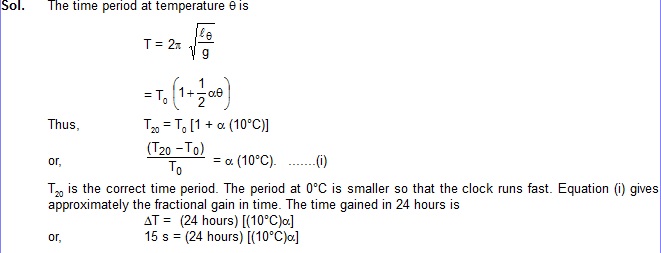

12. A piece of metal weighs 46 g in air and 30 g in a liquid of density 1.24 × 103 kg/m3 kept at 27°C. When the temperature of the
liquid is raised to 42°C, the metal piece weighs 30.5 g. The density of the liquid at 42°C is 1.20 × 103 kg/m3. Calculate the
coefficient of linear expansion of the metal.

13. A sphere of diameter 7.0 cm and mass 266.5 g floats in a bath of liquid. As the temperature is raised, the sphere begins to sink
at a temperature of 35°C. If the density of the liquid is 1.527 g/cm3 at 0°C, find the coefficient of cubical expension of liquid
neglect the expansion of sphere.
Sol. It is given that the expansion of the sphere is negligible as compared to the expansion of the liquid. At 0°C,
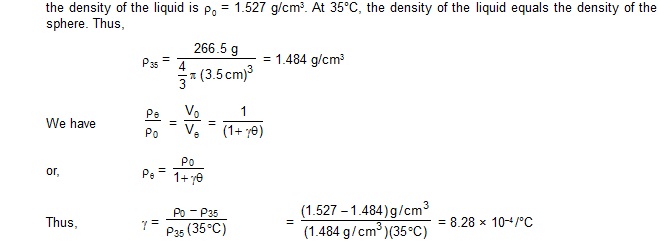
14. An iron rod and a copper rod lie side by side. As the temperature is changed, the difference in the lengths of the rods remains
constant at a value of 10 cm. Find the lengths at 0°C. Coefficients of linear expansion of iron and copper are 1.1 × 10–5 /°C
and 1.7 × 10–5 /°C respectively.
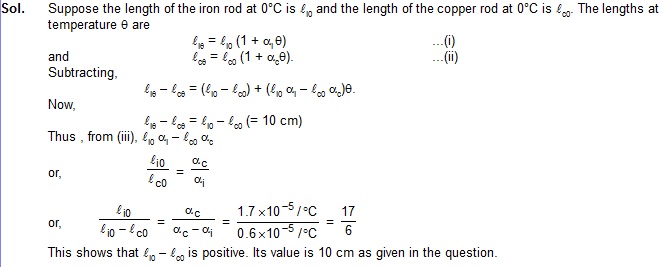

15. A uniform steel wire of cross-sectional area 0.20 mm2 is held fixed by clamping its two ends. Find the extra force exerted
by each clamp on the wire if the wire is cooled from 100°C to 0°C. Young’s modulus of steel = 2.0 × 1011 N/m2.
Coefficient of linear expansion of steel = 2.0 × 10–5/°C.

=(2.0 x 1011N/m2) (1.2 x 10-5/oC) x 100oC x (0.20 x 10-6 m2)=48N
This is equal to the extra force exerted by each clamp.
16. A glass vessel of volume 100 cm3 is filled completely with mercury and is heated from 25°C to 75°C. What volume of
mercury will overflow? Coefficient of linear expansion of glass = 1.8 × 10–6/°C and coefficient of volume expansion
of mercury is 1.8 × 10–4/°C.
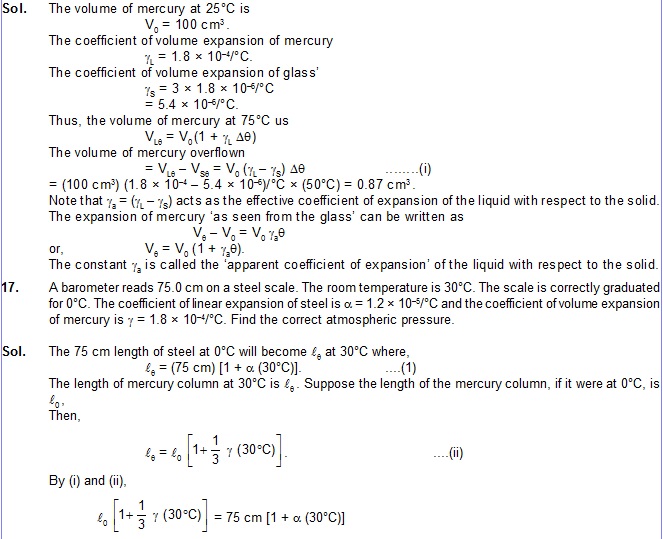

Exercise
1. The steam point and the ice point of a mercury thermometer are marked as 80° and 20°. What will be the temperature
in centigrade mercury scale when this thermometer reads 32°?
Ans. 200 C
2. A constant volume thermometer registers a pressure of 1.500 × 104 Pa at the triple point of water and a pressure of
2.050 × 104 Pa at the normal boiling point. What is the temperature at the normal boiling point?
Ans. 373.3 K
3. A gas thermometer measures the temperature from the variation of pressure of a sample of gas. If the pressure
measured at the melting point of lead is 2.20 times the pressure measured at the triple point of water, find the
melting point of lead.
Ans. 601 K
4. The pressure measured by a constant volume gas thermometer is 40 kPa at the triple point of water.
What will be the pressure measured at the boiling point of water (100°C)?
Ans. 55 kPa
5. The pressure of the gas in a constant volume gas thermometer is 70 kPa at the ice point. Find the pressure at the steam point.
Ans. 96 kPa
6. The pressure of the gas in a constant volume gas thermometer are 80 cm, 90 cm and 100 cm of mercury at the
ice point, the steam point and in a heated wax bath respectively. Find the temperature of the wax bath.
Ans. 2000 C
7. In a Callender’s compensated constant pressure air thermometer, the volume of the bulb is 1800 cc.
When the bulb is kept immersed in a vessel, 200 cc of mercury has to be poured out. Calculate the
temperature of the vessel.
Ans. 307 K
8. A platinum resistance thermometer reads 0° when its resistance is 80 ohm and 100° when its resistance is
90 ohm. Find the temperature at the platinum scale at which the resistance is 86 ohm.
Ans. 60°

10. A concrete slab has a length of 10 m on a winter night when the temperature is 0°C. Find the length of the
slab on a summer day when the temperature is 35°C. The coefficient of linear expansion of concrete is 1.0 × 10–5 /°C.
Ans. 10.0035 m
11. A meter scale made of steel is calibrated at 20°C to give correct reading. Find the distance between 50 cm mark and
51 cm mark if the scale is used at 10°C. Coefficient of linear expansion of steel is 1.1 × 10–5/°C.
Ans. 1.00011 cm
12. A railway track (made of iron) is laid in winter when the average temperature is 18°C. The track consists of sections
of 12.0 m placed one after the other. How much gap should be left between two such sections so that there is no compression
during summer when the maximum temperature goes to 48°C? Coefficient of linear expansion of iron = 11 × 10–8/°C.
Ans. 0.4 cm
13. A circular hole of diameter 2.00 cm is made in an aluminium plate at 0°C. What will be the diameter at 100°C?
alpha for aluminium = 2.3 × 10–5/°C.
Ans. 2.0046 cm
14. Two metre scales, one of steel and the other of aluminium, agree at 20°C. Calculate the ratio aluminium-centimetre/steel-centimetre at
(a) 0°C, (b) 40°C and (c) 100°C. a for steel = 1.1 × 10–5/°C and for aluminium = 2.3 × 10–5/°C.
Ans. (a) 0.99977 (b) 1.00025 (c) 1.00096
15. A metre scale is made up of steel and measures correct length at 16°C. What will be the percentage error if this scale is used
(a) on a summer day when the temperature is 46°C and (b) on a winter day when the temperature is 6°C?
Coefficient of linear expansion of steel = 11 × 10–6/°C.
Ans. (a) 0.033% (b) – 0.011%
16. A metre scale made of steel reads accurately at 20°C. In a sensitive experiment, distances accurate upto 0.055 mm in 1m are
required. Find the range of temperature in which the experiment can be performed with this metre scale.
Coefficient of linear expansion of steel = 11 × 10–6/°C.
Ans. 150C to 250C
17. The density of water at 0°C is 0.998 g/cm3 and at 4°C is 1.000 g/cm3. Calculate the average coefficient of volume
expansion of water in the temperature range 0 to 4°C.
Ans. – 5 × 10–4 / 0C
18. Find the ratio of the lengths of an iron rod and an aluminium rod for which the difference in the lengths is independent
of temperature. Coefficients of linear expansion of iron and aluminium are 12 × 10–6/°C and 23 × 10–6/°C respectively.
Ans. 23 : 12
19. A pendulum clock gives correct time at 20°C at a place where g = 9.800 m/s2. The pendulum consists of a light steel
rod connected to a heavy ball. It is taken to a different place where g = 9.788 m/s2. At what temperature will it give correct time?
Coefficient of linear expansion of steel = 12 × 10–6/°C
Ans. – 820C
20. An aluminium plate fixed in a horizontal position has a hole of diameter 2.00 cm. A steel sphere of diameter 2.005 cm rests on this hole.
All the lengths refer to a temperature of 10°C. the temperature of the entire system is slowly increased. At what temperature will the ball
fall down? Coefficient of linear expansion of aluminium is 23 × 10–6/°C and that of steel is 11 × 10–6/°C.
Ans. 2190 C
21. A glass window is to be fit in an aluminium frame. The temperature on the working day is 40°C and the glass window measures exactly
20 cm × 30 cm. What should be the size of the aluminium frame so that there is no stress on the glass in winter even if the temperature
drops to 0°C? Coefficient of linear expansion for glass and aluminium are 9.0 × 10–6/°C and 24 × 10–6/°C respectively.
Ans. 20.012 cm × 30.018 cm
22. The volume of glass vessel is 1000 cc at 20°C. What volume of mercury should be poured into it at this temperature so that the volume
of the remaining space does not change with temperature? Coefficient of cubical expansion of mercury and glass are 1.8 × 10–4/°C and
9.0 × 10–6/°C respectively.
Ans. 50 cc
23. An aluminium can of cylindrical shape contains 500 cm3 of water. The area of the inner cross-section of the can is 125 cm2.
All measurements refer to 10°C. Find the rise in the water level if the temperature increases to 80°C. The coefficient of linear
expansion of aluminium = 23 × 10–6/°C and the average coefficient of volume expansion of water = 3.2 × 10–4/°C respectively.
Ans. 0.089 cm
24. A glass vessel measures exactly 10 cm × 10 cm × 10 cm at 0°C. it is filled completely with mercury at this temperature.
When the temperature is raised to 10°C, 1.6 cm3 of mercury overflows. Calculate the coefficient of volume expansion
of mercury. Coefficient of linear expansion of glass = 6.5 × 10–6/°C
Ans. 1.8 × 10–4 /0C
25. The densities of wood and benzene at 0°C are 880 kg/m3 and 900 kg/m3 respectively. The coefficients of volume expansion are
1.2 × 10–3/°C for wood and 1.5 × 10–3/°C for benzene. At what temperature will a piece of wood just sink in benzene?
Ans. 830 C
26. A steel rod of length 1m rests on a smooth horizontal base. If it is heated from 0°C to 100°C, what is the longitudinal strain developed?
Ans. zero
27. A steel rod is clamped at its two ends and rests on a fixed horizontal base. The rod is unstrained at 20°C. Find the longitudinal strain
developed in the rod if the temperature rises to 50°C. Coefficient of linear expansion of steel = 1.2 × 10–5/°C.
Ans. – 3.6 × 10–4
28. A steel wire of cross-sectional area 0.5 mm2 is held between two fixed supports. If the wire is just taut at 20°C, determine the
tension when the temperature falls to 0°C. Coefficient of linear expansion of steel is
1.2 × 10–5/°C and its Young’s modulus is 2.0 × 1011 N/m2.

Ans. 24 N
29. A steel rod is rigidly clamped at its ends. The rod in under zero tension at 20°C. If the temperature rises to 100°C, what force will
the rod exert on one of the clamps. Area of cross-section of the rod = 2.00 mm2. Coefficient of linear expansion of steel
= 12.0 × 10–6 /°C and Young’s modulus of steel = 2.00 × 1011 N/m2.
Ans. 384 N
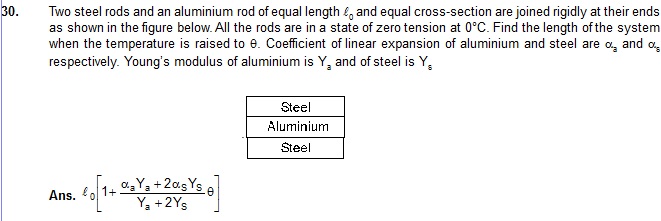
31. A steel ball initially at a pressure of 1.0 × 105 Pa is heated from 20°C to 120°C keeping its volume constant. Find the pressure
inside the ball. Coefficient of linear expansion of steel = 12 × 10–6/°C and bulk modulus of steel = 1.6 × 1011 N/m2.
Ans. 5.8 × 10–8 Pa

34. A circular disc made of iron is rotated about its axis at a constant velocity w. Calculate the percentage change in the linear
speed of a particle of the rim as the disc is slowly heated from 20°C to 50°C keeping the angular velocity constant.
Coefficient of linear expansion of iron = 1.2 × 10–5/°C.
Ans. 3.6 × 10–2